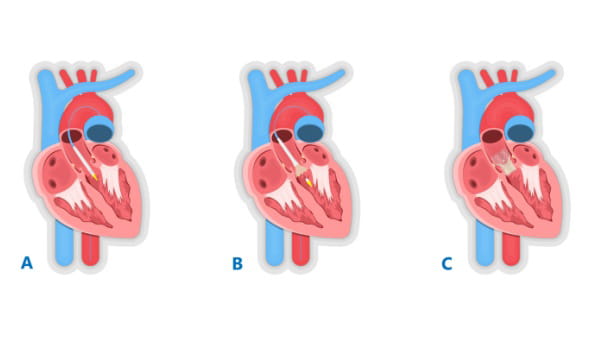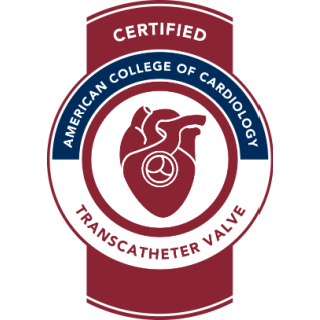About Transcatheter Aortic Valve Replacement
Transcatheter aortic valve replacement (TAVR) is a minimally invasive procedure used to treat patients with aortic stenosis, a condition where the aortic valve becomes narrowed and does not open properly. This reduces blood flow to the rest of the body and forces the heart to work harder. Without treatment, aortic stenosis can cause long-term heart damage.
This treatment has improved the quality of and saved the lives of patients as west central Florida’s leader in heart care for adults and children, BayCare was the first health care system in Tampa Bay to offer TAVR. BayCare’s Morton Plant Hospital in Clearwater began offering this revolutionary treatment in 2012.
At BayCare, our three world-class Structural Heart and Valve programs provide patients throughout west central Florida with access to expert heart valve care. All BayCare facilities have multidisciplinary heart teams who work together to deliver comprehensive care for complex valve disorders. This team approach ensures that your case is thoroughly reviewed, resulting in a well-coordinated treatment plan tailored to your needs.
Procedure Details
Unlike traditional open-heart surgeries, TAVR is performed through a small opening in a blood vessel. A special catheter is used to place an expandable replacement valve into the existing aortic valve.
During a TAVR procedure, a team of doctors inserts a catheter through a blood vessel in your groin or chest. This catheter contains the new, self-expanding or balloon expanded aortic valve. Once the catheter is in position, your surgeon will put the replacement valve inside your existing aortic valve and expand it. As it expands, the new valve pushes aside your existing valve’s leaflets. Once the team determines the new valve is functioning properly, the catheter is removed, and if needed the entry point is stitched up. This procedure typically takes 1-2 hours.

Illustration of a TAVR procedure’s basic steps:
A: A catheter is introduced into the existing aortic valve.
B: A new collapsed replacement valve is positioned and expanded.
C: The new valve fits securely inside your existing valve. The catheter is removed.
-
Before TAVR
To determine if you’re a candidate for TAVR, our Structural Heart and Valve programs may use a variety of diagnostic testing to confirm aortic stenosis, its severity and the best treatment plan for you. Diagnostic testing may include:
- Blood tests
- Echocardiogram
- Electrocardiogram (ECG or EKG)
- Cardiac CT (computed tomography) scan
- Cardiac magnetic resonance imaging (MRI)
- Diagnostic Cardiac catheterization
Once all test results are received, our team of experts – cardiovascular physician and surgeons, cardiothoracic surgeons, structural heart cardiologists, cardiac anesthesiologists, cardiac imaging specialists, and other cardiac care specialists –reviews them together. They will recommend the best treatment option.
Once you and your Structural Heart and Valve team decide TAVR is right for you, our team will work with you to schedule your procedure. Once a procedure date is confirmed, your preoperative testing appointment (sometimes call a pre-admission testing appointment) will be scheduled. During this appointment, the team will go over pre-procedural instructions including:
- Which medications you can take and which ones must be stopped and by when
- When to stop eating and drinking before the procedure
- What to wear the day of the procedure
- How and where to check in on the day of your procedure
Your arrival time at the hospital will be confirmed via phone call the day before your procedure is scheduled to take place.
-
TAVR Procedure Day
After checking in at your BayCare hospital, you’ll be brought into the pre-op area. Our team will go through any additional consents needed for the procedure, confirm your information, and begin getting you ready for the procedure. You may meet with members of your treatment or anesthesia teams. Your vital signs will be taken and you’ll receive an IV in your arm or hand. This IV is used for sedation and other medications. Most patients are sedated, though some may receive general anesthesia. Once all pre-procedure items are completed, you’re moved to the hybrid operating room. TAVR procedures are performed inside a state-of-the-art hybrid operating room with special imaging equipment.
-
After a TAVR Procedure
After a TAVR procedure, most patients stay overnight in the hospital and are discharged the next day. Your Structural Heart and Valve team will provide postoperative instructions for the weeks following your procedure.
Most patients resume their normal, pre-procedure activities within a few days with some general restrictions, such as when you can lift heavy items or drive. You’ll also need periodic follow-up appointments and tests with your team.
Cardiac rehabilitation may also be prescribed as part of your recovery plan. Cardiac rehabilitation is offered at the following BayCare locations:
The Advantages of a TAVR Procedure
TAVR has many benefits including:
- Minimally invasive approach with no large surgical incisions
- Faster recovery
- Improved symptoms, quality of life and life expectancy
- Shorter hospital stays
- Improved blood circulation
- Lower risk of stroke and blood loss
- Reduced hospital stays for those with heart failure
- Does not require stopping the heart or the use of a heart-lung machine

TAVR at BayCare: Why Choose Us?
There are many benefits to choosing BayCare for your heart valve care. BayCare was the first to perform TAVR procedures in west central Florida in 2012. Our Structural Heart and Valve teams are experts, performing hundreds of TAVR procedures each year.
All BayCare’s programs are accredited with Transcatheter Valve Certification from the American College of Cardiology (ACC). This certification ensures that we follow the best practices and use data to track patient safety and outcomes for transcatheter valve treatments.
Hospitals with this certification use best practices for implementing evidence-based medicine to support patient-centered decision-making and track key performance data to find areas for improvement. BayCare also participates in clinical research trials for various heart valve and structural heart conditions.
-
Who is a good candidate for TAVR?
Candidacy for TAVR is typically determined after a thorough review of each patient. Generally, candidates for TAVR are those who:
- Have symptomatic or severe aortic stenosis
- Are of older age
- Have other comorbid conditions that would make open-heart surgery dangerous or difficult such as diabetes, liver or kidney disease, chronic obstructive pulmonary disease (COPD), and heart failure
- Those who have had prior heart surgery
-
Who isn’t a good candidate for TAVR?
Though the TAVR procedure carries significant benefits for some patients, it is not suitable for everyone. The best way to determine candidacy is to be reviewed by one of our Structural Heart and Valve teams. Generally, those who have had a recent heart attack or stroke, severe weakening of the heart, or problems with an additional heart valve, may not to be good candidates for TAVR. Sometimes a person’s anatomy isn’t favorable for the type of valve used in this treatment.
-
What are the risks or complications or TAVR?
Like all medical procedures, the TAVR procedure does carry risks. Risks to discuss with your structural heart and valve team include:
- Infection
- New need for a pacemaker
- Bleeding or blood vessel damage
- Stroke
- Kidney damage
- Procedure conversion to emergency traditional open-heart surgery
- Heart attack
- Death
-
How long does a new TAVR valve last?
It’s difficult to predict how long a TAVR valve will last as many factors can impact how fast a man-made valve could wear out. Most TAVR valves used are designed to last about 10 years. Discuss all concerns related to the device with your Structural Heart and Valve team.
-
Do I need to take blood thinners after TAVR?
For most patients, “blood thinners” (also called anticoagulants) may be required after a TAVR procedure. These medications help prevent blood clots from forming around your new heart valve. Your Structural Heart and Valve team will help determine which medications might be right for you and how long you must take them. It’s important you take these medications as prescribed. Talk with your team if you have concerns about taking blood thinning medications.

Aortic Stenosis Causes, Symptoms and Progression
Aortic stenosis is one of the most common and serious valve disease problems. Listen as Dr. Joshua Rovin, a cardiovascular surgeon and director of the Center for Advanced Valve and Structural Heart Care at Morton Plant Hospital, discusses the main symptoms, causes and progression of aortic stenosis.

Heart Valve Disease
Interventional cardiologist Dr. Jayendrakumar Patel discusses heart valve disease including signs, symptoms and when to see a cardiologist.Learn more about BayCare's heart valve centers

